Cepheus, the King, has hidden his treasure well, but not so well that curious amateurs can't find more than enough to stuff their pockets.
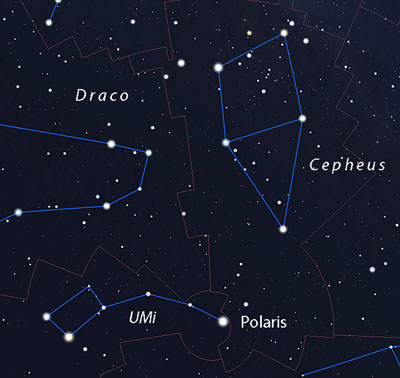
Stellarium
When my kids were younger they loved to listen to the iconic In the Hall of the Mountain King from Edvard Grieg's Peer Gynt. The music so perfectly captures Peer's desperate attempt to escape the mountain trolls and the troll king. But just when all seems hopeless, he's saved by the rays of the rising Sun and the sound of distant church bells, two things the beasts cannot bear.
At nightfall in October, Cepheus, King of the Sky, looks down upon the chilling earth and tempts skywatchers with similar riches. None of us need fear his wrath — these treasures are free for the taking. I'm always amazed how much Cepheus has to offer, so much that I'm only going to describe a few of my favorites. While the constellation is circumpolar from mid-northern latitudes and open for observation year-round, it stands directly on the meridian at nightfall in early October, making this the best time for observers at more southerly latitudes to obtain their kingly rewards.
At the Foot of the King
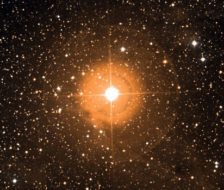
Aladin Sky Atlas
We'll start with one of the biggest and most distant stars easily visible with the naked eye, Mu (μ) Cephei, better known as the Garnet Star. This red supergiant is 2,840 light-years away with a diameter more than 1,000 times that of the Sun. In my scope it's a tiny, yellow-orange spotlight. Were Mu moved to Vega's distance of 25 light-years it would shine at magnitude –8.3, more than 40 times brighter than Venus!
Mu takes us directly to the expansive and utterly amazing object called IC 1396, a mélange of emission and dark nebulae, two striking double stars, and stellar glitter provided by members of the open cluster Trumpler 37. The complex is about 2.5° across. For the bright and dark nebulae use your lowest magnification and an O III or similar nebula filter. An ideal telescope would be a 6- or 8-inch rich-field telescope with a super-wide field of view. In my 15-inch, with its 1° field, I had to make several sweeps across the cavernous object to make sense of it all, but when I did, I clearly saw a thick wreath of variably bright nebulosity spread across two fields of view ½° south of Mu Cep .
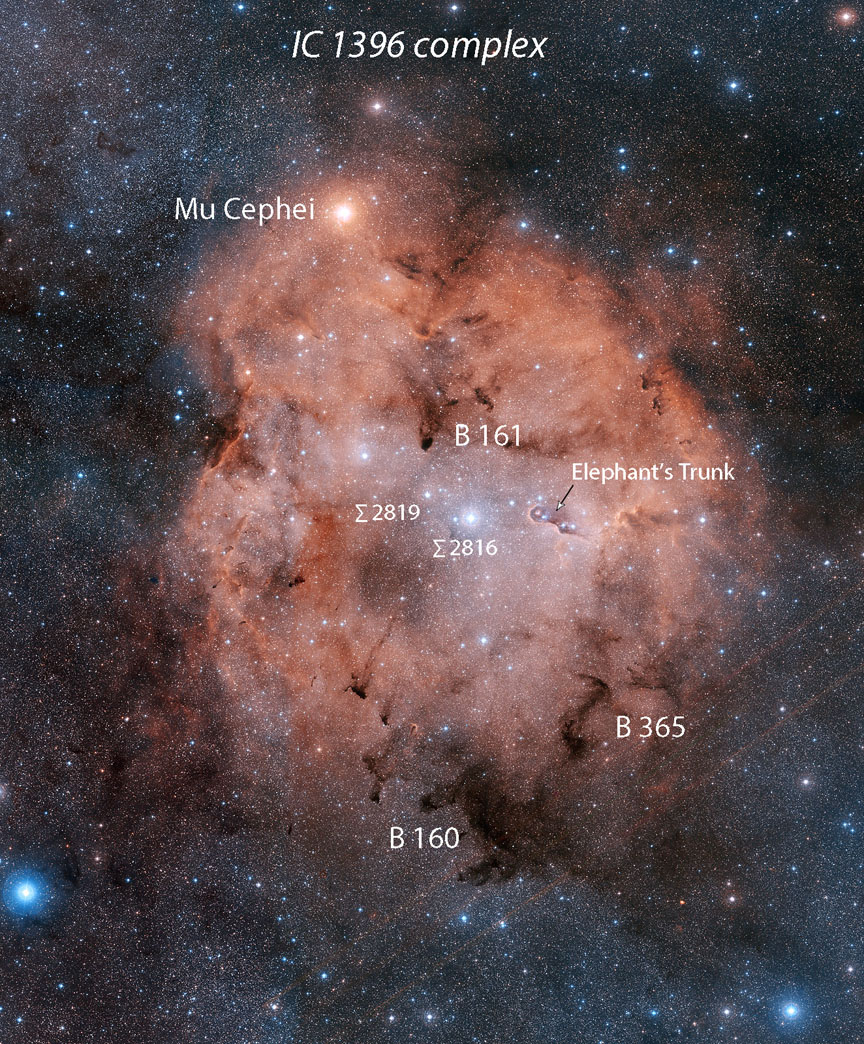
Digitized Sky Survey, ESA, ESO, NASA with composite by Davide De Martin
The wreath's northern half glowed brightest and was plain to see but no structure was evident, just a diffuse haze. Barnard 161, located in the northern half of IC 1396, was an obvious dark spot, especially with averted vision. Photos show a dark, 3′-wide cometary "head" that widens and fades to the north. Dark nebula visibility is rated by opacity from 1 for least opaque (most transparent) to 6 for most opaque. B161's opacity is 6 and it contrasts well against the surrounding nebulosity. I also saw hints of two other objects chewing into the wreath's southern border — B160 (opacity = 4) and B165 (5).
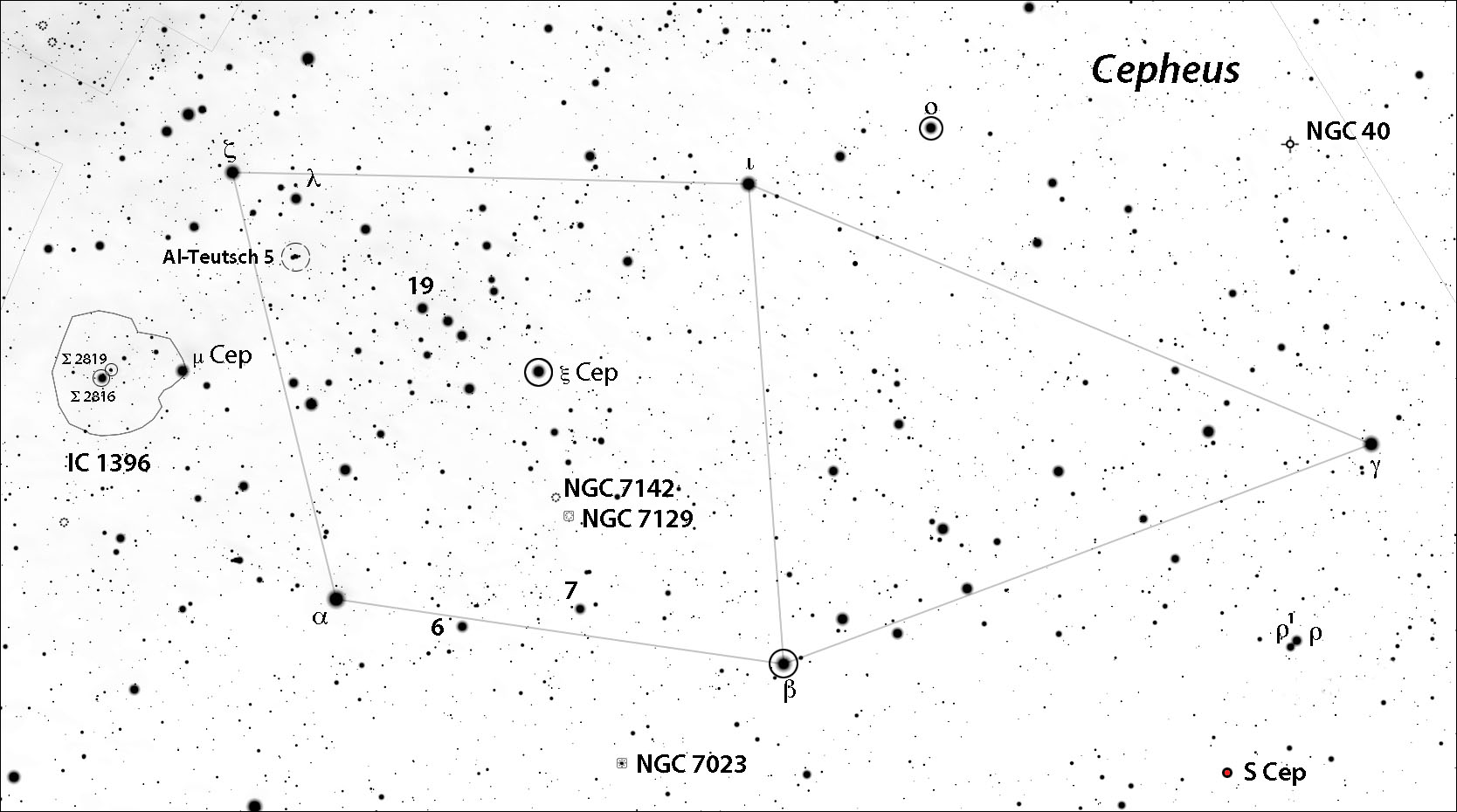
Stellarium with additions by the author
But what really grabs your attention when you first arrive at IC 1396 is the remarkable triple/double star pair Σ2816 and Σ2819. Σ2816 is a bright little bird winging across the nebula with a 5.7-magnitude primary flanked by two magnitude-7.5 stars at 12″ and 20″ to the northeast and northwest. Hands down one of the finest triples in the sky for a small telescope. Look 12′ to the northeast and you can't miss its cohort Σ2819, a pretty pair of stars (magnitudes 7.5 and 8.5) separated by 13″. Both stars are members of the cluster Trumpler 37, the loose assemblage embedded within the nebula.
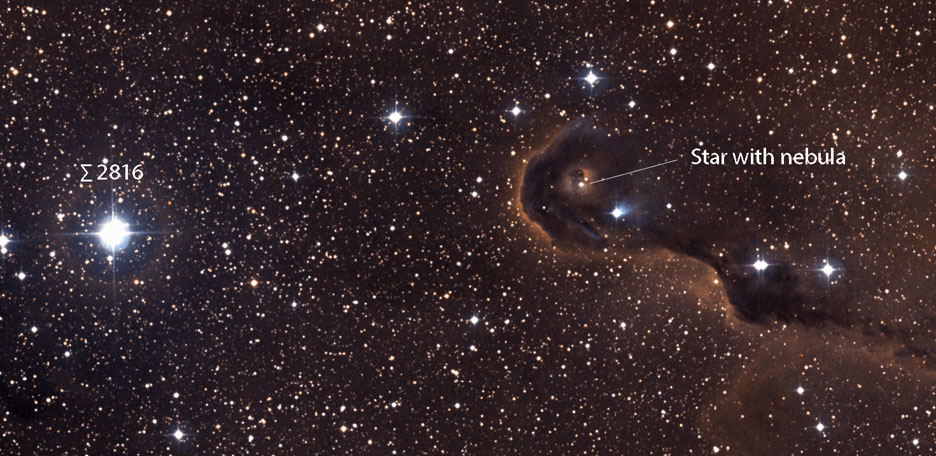
Aladin Sky Atlas
Finally, there is the Elephant's Trunk Nebula or Van den Bergh 142 (vdB 142), a dark, dusty cloud the edges of which are illuminated and ionized by the triple star Σ2816 located about 18′ due east. A reflection nebula is centered on the 12th-magnitude star in the "eye" of the elephant. To see it, remove the nebula filter and apply high magnification (150× and up). It was subtle but I could make out a small, round glow centered on the star like a distant candle seen through fog.
With the filter back in place, I used averted vision and magnifications of 64× and 142× to spy the fingerlike dark "trunk" that extends about 15′ to the west. I guess it looked like an elephant's trunk but Cheetos came first to mind.
Doubling Up
From IC 1396 we head straight north into the heart of Cepheus to Xi (ξ) Cephei, one of my favorite doubles. This 4.3-magnitude star splits into an exquisite pair with magnitudes of 4.8 and 6.3 separated by 8″. They're just close enough to each other and at 64× glimmer in a thrilling way while maintaining the sharpness inherent in low-power views. You could go higher but don't. Make your eye work just a teeny bit on this one.
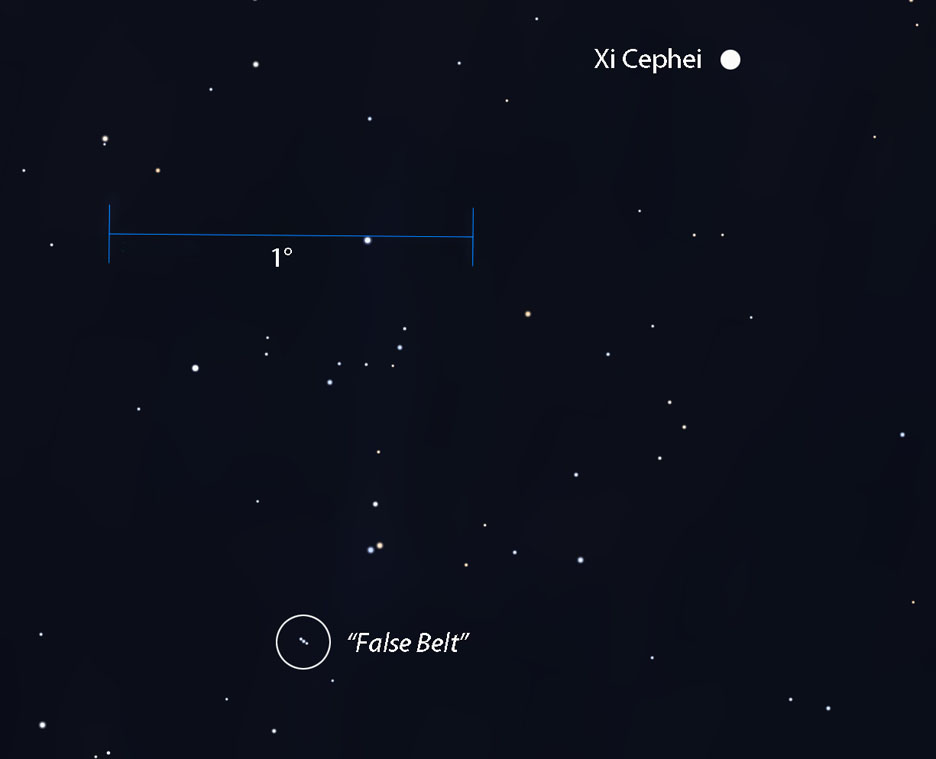
Stellarium
Next, try 3rd-magnitude Beta (β) Cephei with a 7.8-magnitude companion 13.6″ to the southwest. The pair's relatively close separation and similar magnitude difference make it look like a slightly wider version of Xi Cep. The brighter star may not pique your interest at first glance but that's only because of its enormous distance of nearly 900 light-years. Beta blazes with a luminosity 23,000 times that of the Sun, and it's 13 times as massive.
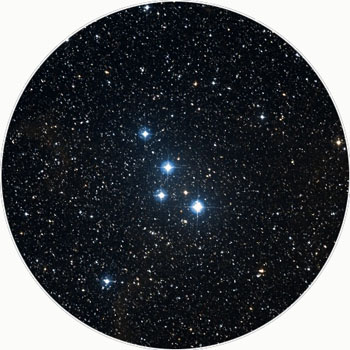
Aladin Sky Atlas
In the chart above I mentioned seeing a minute version of Orion's Belt. Cepheus has another likely asterism worth a visit — a compact knot of four 7th- and 8th-magnitude stars called Alessi-Teutsch 5 located about 2° northwest of Zeta (ζ) Cephei. A worthy pretender, it's a neat sight in a pair of binoculars or your finderscope.
If you're looking for closer company, slide over to Omicron (ο) Cephei, a tight, unequal duo with magnitudes of 5 and 7.3 separated by 3.4″. I sliced them apart with 245× and enjoyed the primary's pleasing golden tone. The secondary shines close by at position angle 224° (southwest).
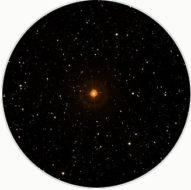
Aladin Sky Atlas
Before returning to the deep sky, we'll make one last stellar stop — S Cephei, a deep-red carbon star that waxes and wanes from magnitude 7.4 to 12.9 and back every 487 days. Right now, it shines at 7.2 — close to maximum — an easy sight in binoculars. Through my 15-inch a couple weeks back it glowed a gorgeous cherry-red. For a detailed finder chart to follow it from bright to faint, go to the AAVSO website, type S Cep in the Pick a Star box and then click Create a Finder Chart.
Back Into the Deeps
Do not leave Cepheus until you've looked at the Iris Nebula (NGC 7023). This bright reflection nebula is illuminated by the massive, pre-main-sequence star HD 200775, the 7th-magnitude object at its center. At first glance you'll see the star swaddled in vague nebulosity, but if you increase the magnification to 100× or more, an amazing amount of structure emerges.
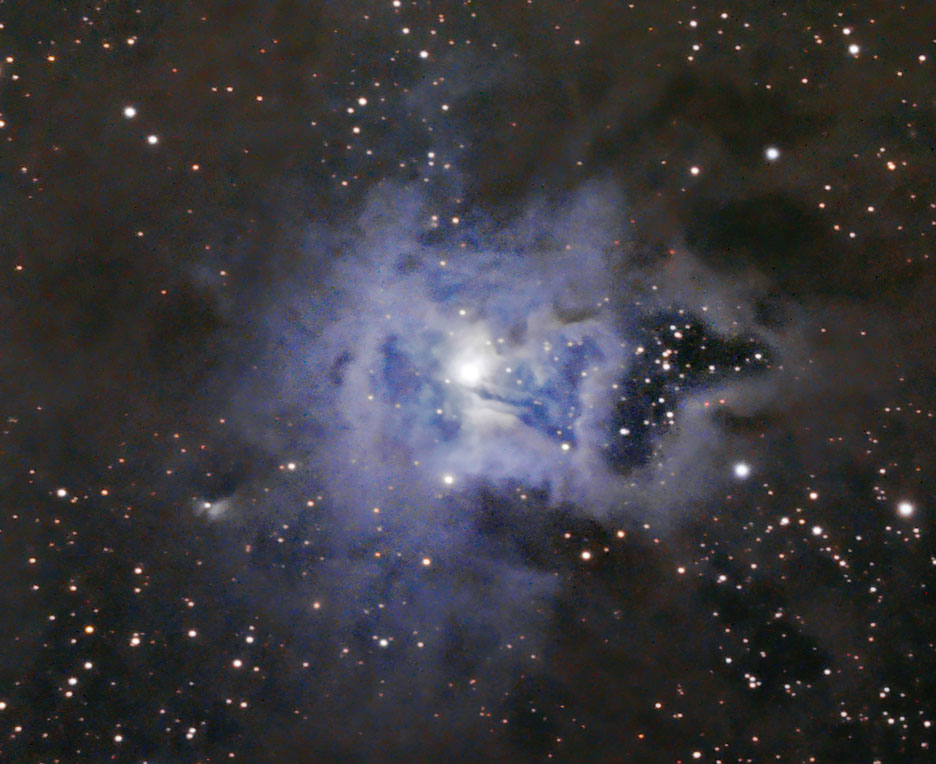
Hunter Wilson
The brightest blob surrounds the central star while a fainter oval patch is visible to its south, nearly touching. East of the central star I saw a thick bar of luminous dust and a fainter, broader, less defined glow to the west of the star. Photographs of the nebula recall an iris bloom but visually it's closer to a tulip with the central star as the pistil.
Another kingly sight is the pairing of the reflection nebula NGC 7129 with the rich open cluster NGC 7142. NGC 7129 is a cluster in the making, and it fresh-faced stars are responsible for illuminating their birth cloud, a 7′-wide nebula with an overall magnitude of 11.5. I saw about a dozen stars swathed in nebulosity with the brightest patches around the two brightest stars (magnitudes 9.5 and 10.6). Another smaller condensation smears a fainter star immediately to the northwest of the duo. Just ½° southeast in the same field of view NGC 7129 may catch your eye.
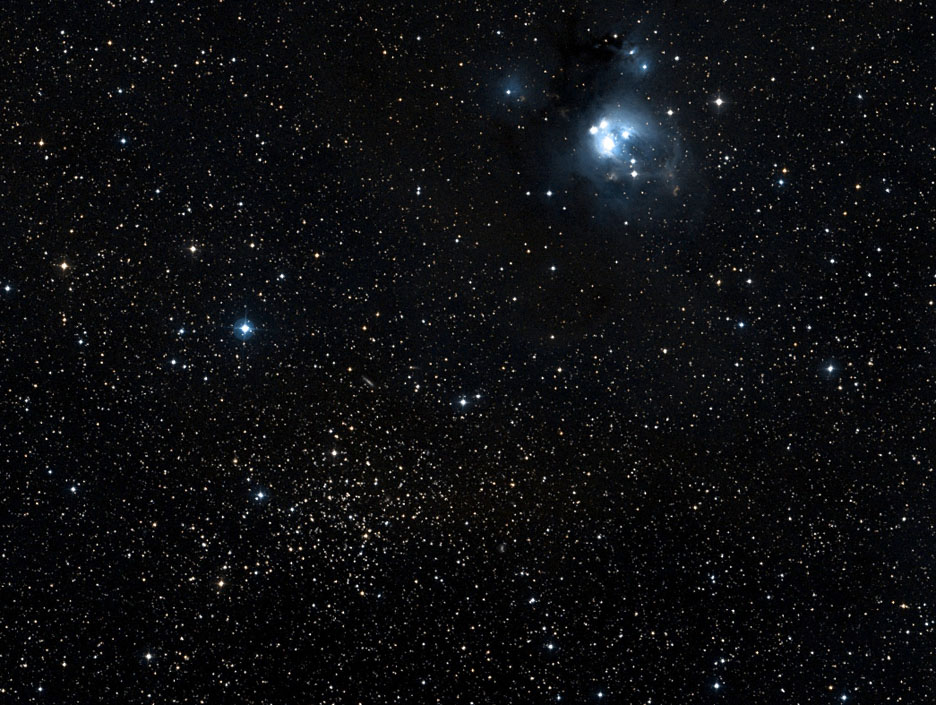
Aladin Sky Atlas
Increase your magnification here to 100× or higher to better make out the many faint stars packed into its 12′ diameter. The brightest is 11th magnitude, but most of the ~180 members glimmer at 13 or fainter; together they create a fine mist of stars very pleasing to the eye. The area is liberally sprinkled with interstellar dust which is in part responsible for dimming the group. But that's not the only reason for its faintness. NGC 7142 lies about 6,200 light-years away while its apparent neighbor, NGC 7129, is only 3,300 light-years distant. Seeing them together allows us to imagine them in three dimensions with the nebula in the foreground and the cluster far, far away.
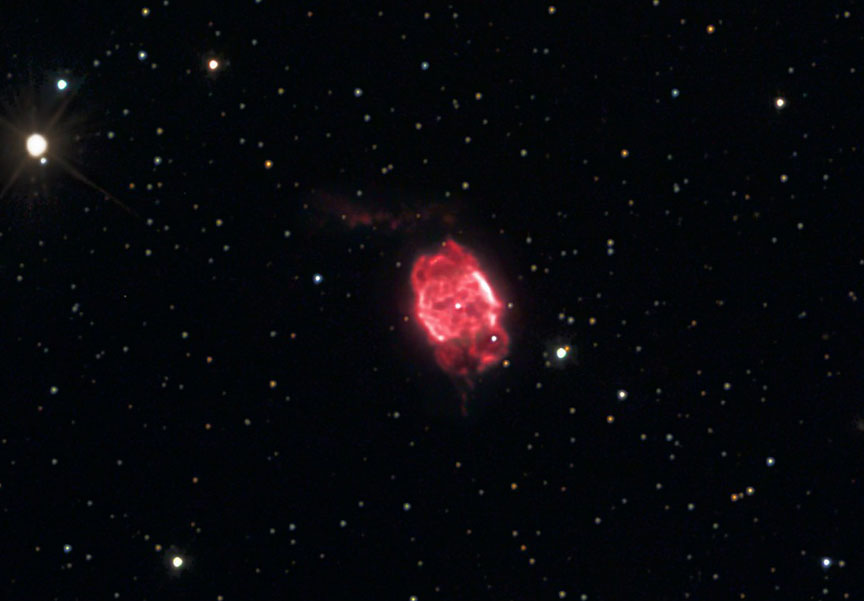
Jim Misti
We've touched on asterisms, open clusters and nebulae but the Sky King is home to several fine planetary nebulae including NGC 40, the brightest resident at magnitude 10.7. A sizzlingly hot white dwarf with a temperature of 50,000°C occupies the center and blasts its former atmosphere with energetic ultraviolet light, exciting it to glow. Using magnifications of 142× and 245× on the 15-inch I made out a distinct shell with a darker interior slightly elongated in the north-south direction. The western half appeared brighter and more sharply defined than the east. This planetary mimics the better known "Blinking Planetary" NGC 6826 in Cygnus. If you stare hard at the bright central star the nebula almost disappears. Switch back to averted vision and boom — it reappears!
Although my pockets are bulging with deep-sky treasures after a visit to the lair of King Cepheus I fear I've barely touched on the totality of what the constellation offers. Take this as a first foray. I promise we'll return another night.
 4
4









Comments
Rod
October 2, 2019 at 12:03 pm
Bob, very good report and charts here. Friday night at my location in Maryland looks good for some stargazing. Perhaps I will try some of the low hanging fruit in this report using my 10-inch Newtonian. The Moon is nearly First Quarter and does not set until about 2316 EDT but I may be able to enjoy some views in Cepheus. I plan to use my 90-mm refractor too.
You must be logged in to post a comment.
Bob KingPost Author
October 8, 2019 at 1:36 am
Excellent, Rod! There are objects in the article for big and small instruments. Clear skies!
You must be logged in to post a comment.
Joe Stieber
October 2, 2019 at 4:32 pm
Bob -- Another great article with some great targets. I realize there's a limit to how much you can cover in a single article, but I don't see any mention of one of Cepheus' most notable stars -- Delta (δ) Cephei. Delta is at the far vertex of a compact triangle at the southeast corner of the house-like stick figure, but I don't see it labeled on the finder chart. Of course, Delta Cep is the type example for the Cepheid variables, one of the fundamental benchmarks for distance measurement in the universe. It's also an attractive double star! Since it's relatively bright, about magnitude 4, it's not a challenge to spot (perhaps that's why it's not in the article), but observers can easily check their own charts and give it a glance while working Cepheus for the other objects.
You must be logged in to post a comment.
Bob KingPost Author
October 8, 2019 at 1:38 am
Hi Joe,
Yes, that's a nice double, too. I didn't include it because I've written about Delta before but mostly because I had to limit my ever-growing list! I'm glad you mentioned it as something observers can include while on their Cepheus visit.
You must be logged in to post a comment.
You must be logged in to post a comment.